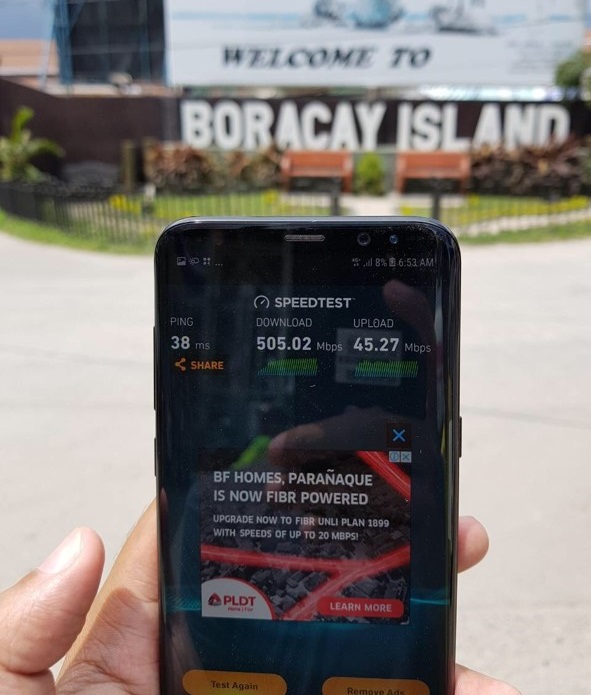If you have a Samsung Galaxy S8 or Samsung Galaxy S8+ and a Smart LTE SIM, you can have an even better mobile data experience using Smart’s upgraded networks in the country’s premier tourist destination, Boracay Island.
Smart, with strategy and technology partner Huawei Technologies Philippines, has successfully activated 4-component carrier (4CC) aggregation in Boracay, reaching average speeds of 280 Mbps in initial runs using test software on Samsung’s latest flagship smartphones the Galaxy S8 and Galaxy S8+, 4CC carrier aggregation-capable smartphones available in the market.
Initial tests have also achieved promising speeds of up to 400 to 500 Mbps via 4×4 Multiple Input, Multiple Output (MIMO) and 256 Quadrature Amplitude Modulation (QAM) technology on a live and loaded network in Boracay, using the Galaxy S8, Galaxy S8+ and software that is available to users via a software update.
“This is just a preview of what can be achieved using the network that Smart is currently rolling-out and continuously improving throughout the country,” said Mario G. Tamayo, PLDT and Smart Senior Vice President for Network Planning and Engineering.
“Even for those who are using other LTE handsets, our network already delivers a better level of service,” Tamayo added.

Smart has been rolling out its LTE and LTE-Advanced network upgrades in the country’s major urban hubs–Metro Manila, Rizal, Metro Cebu and Metro Davao.
LTE-A has a capability called “Carrier Aggregation” (CA), which allows it to combine two or more radio frequency bands in order to deliver bigger bandwidth and much faster data speeds to mobile users. 4CC aggregation features the combination of four separate spectrum blocks to deliver much greater capacity and speeds.
Like CA, 4×4 MIMO and 256QAM are also technologies that help increase speeds. For instance, the 4×4 MIMO capability uses four antenna ports to transmit and receive data between the base station and smartphone. With 4×4 MIMO, data transmission rates can be quadrupled.
“However, the use of these new technologies to achieve great speeds is still device-dependent. For example, at the moment there are only a few devices that can use these technologies and are available in the market, such as the Samsung Galaxy S8 and Galaxy S8+,” Tamayo explained.
LTE, LTE-A rollout
Smart rolled out the country’s first LTE-A service in Boracay in April last year in anticipation of the rise of bandwidth-heavy services such as video streaming and gaming. Since then, Smart has also successfully activated the network’s 2CC and 3CC carrier aggregation capabilities.
LTE-A base stations have since been deployed in Metro Manila, Rizal, Metro Cebu and Metro Davao, where subscribers with LTE-A capable SIMs and handsets can stream TV shows and movies without buffering and play online games without lag, among other possibilities.
The ongoing LTE and LTE-A rollout is part of a broader effort to improve overall quality of service available to Smart subscribers. LTE, which provides the best mobile experience to users, is easily upgradable to LTE-A and LTE-Advanced Pro or Gigabit LTE, and lays the foundation for the coming of 5G in 2020.
The current network improvement activities in Metro Manila aim to improve indoor LTE and 3G data signal, as well as indoor 3G and 2G voice signal. Smart is targeting to expand the number of municipalities with LTE coverage to 783 by the end of this year, about half of the three-year target of 1,551 municipalities by the end of 2018.
“We are asking for people’s patience and understanding as we are upgrading our network facilities. We assure you that we are taking steps to minimize the impact of these activities on our subscribers. In the end, our commitment to all our subscribers is that they will enjoy progressively better mobile data services in the next few months, particularly for those using LTE devices,” said Tamayo.
The backbone of the PLDT group’s digital pivot, this comprehensive network modernization and expansion program features re-equipping cell sites to provide better indoor coverage and increase the capacity of each Smart cell site to handle more calls, texts, and ever-increasing mobile data traffic.
Smart’s network rollout took a big bulk of parent company PLDT’s ramped-up capital expenditure program of P42.8 billion for 2016, which included the utilization of the new frequencies freed up with the acquisition of San Miguel Corporation’s telco assets. PLDT chair and CEO Manuel V. Pangilinan has announced a total capital expenditure of P46 billion this year.

